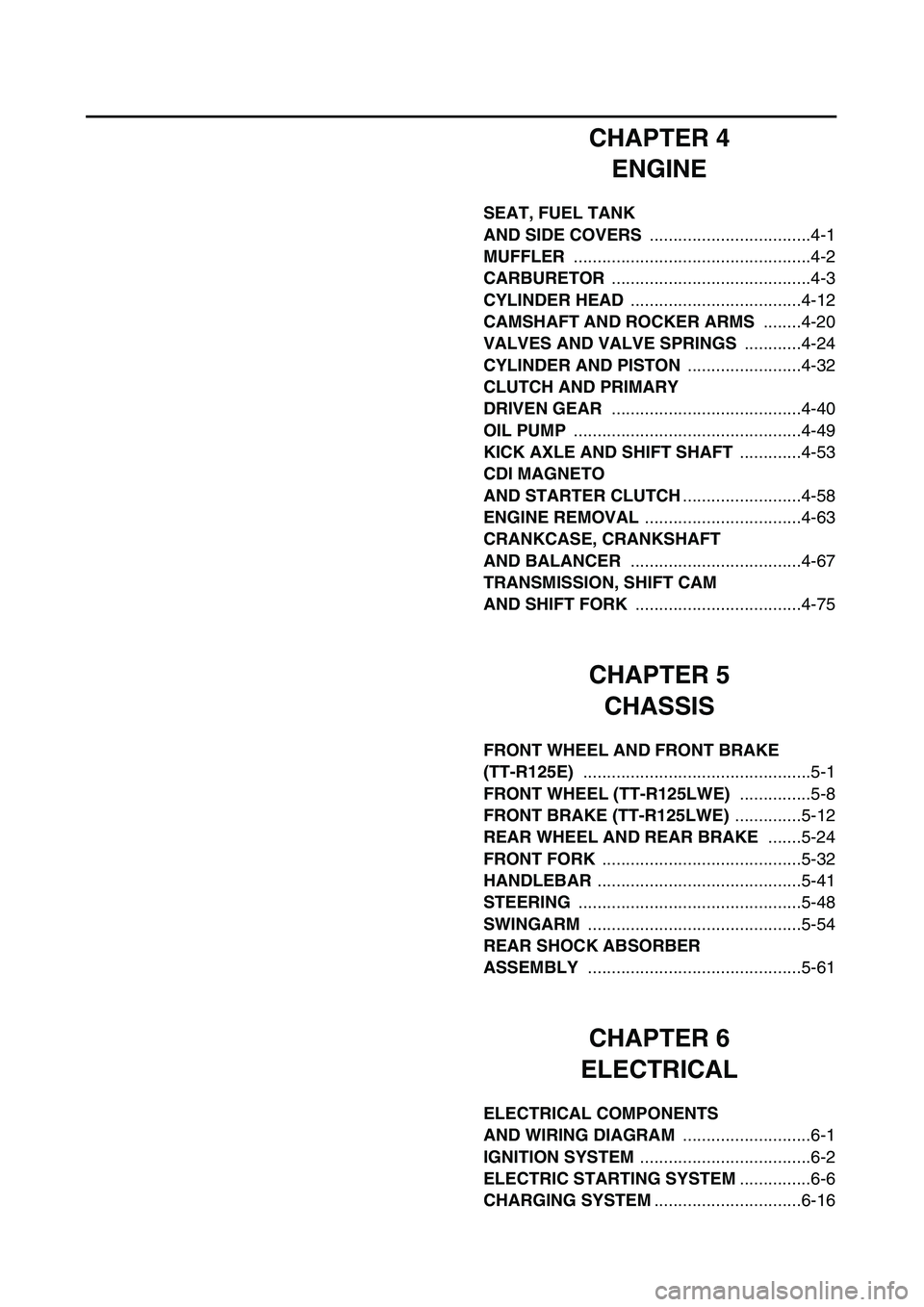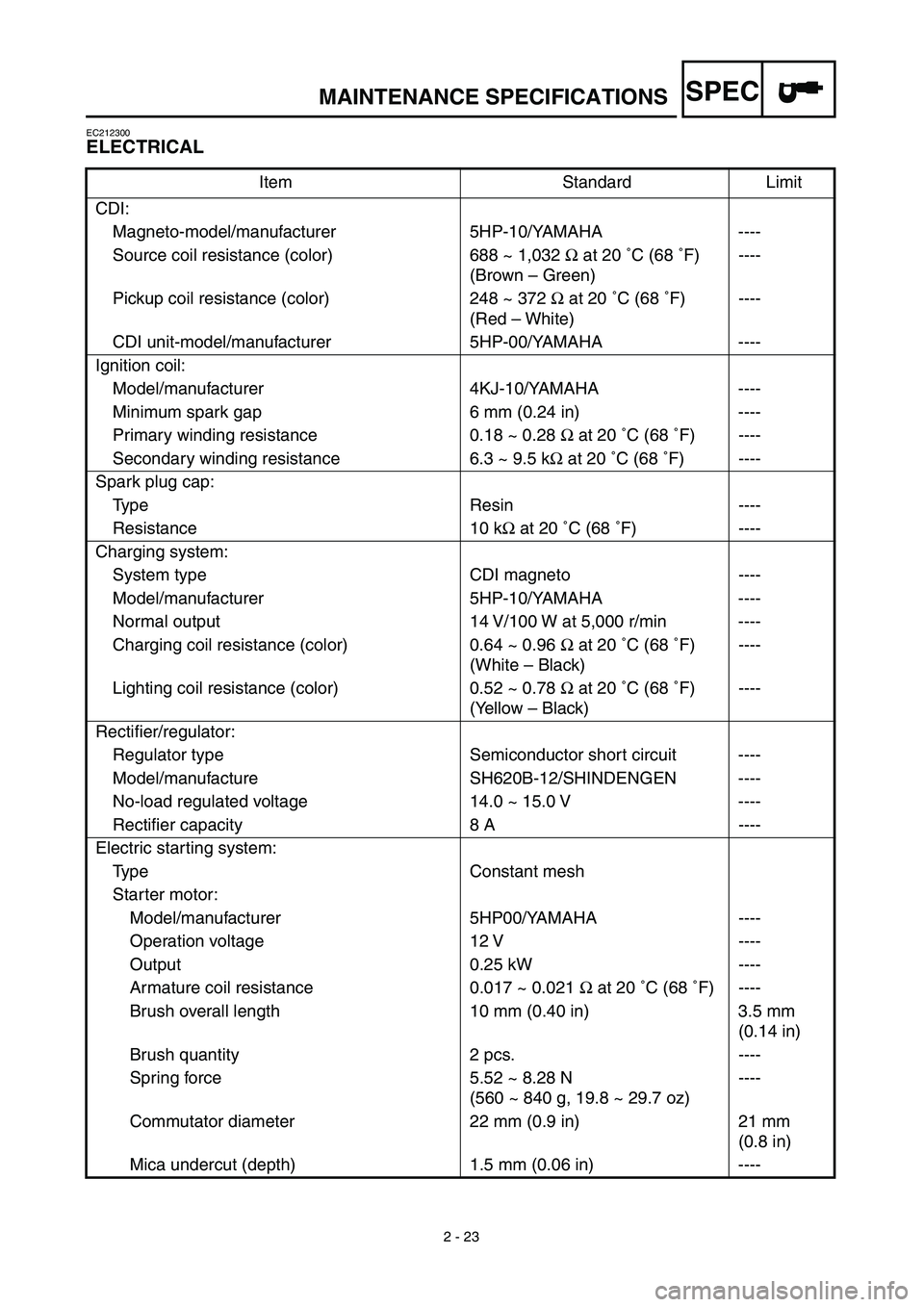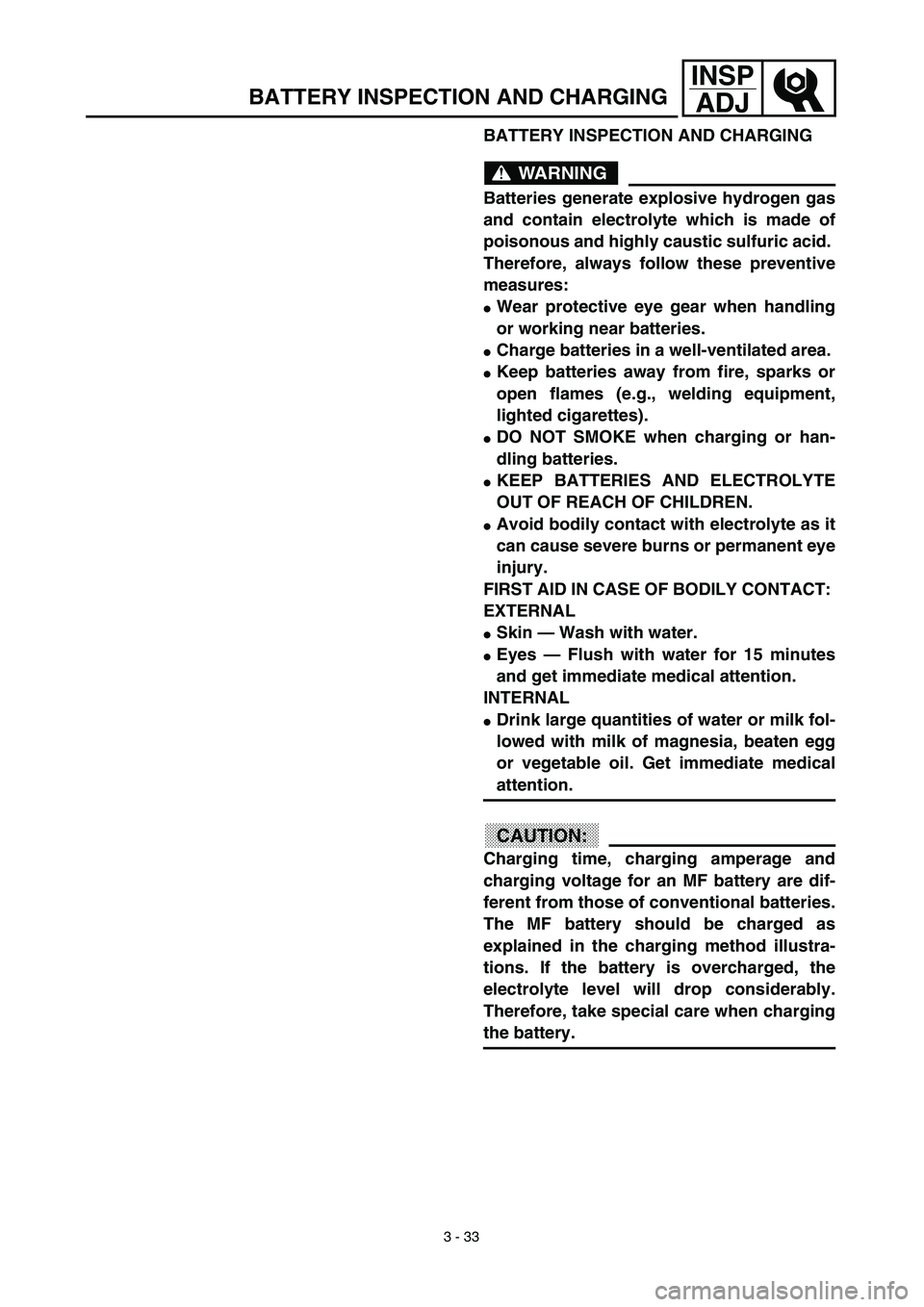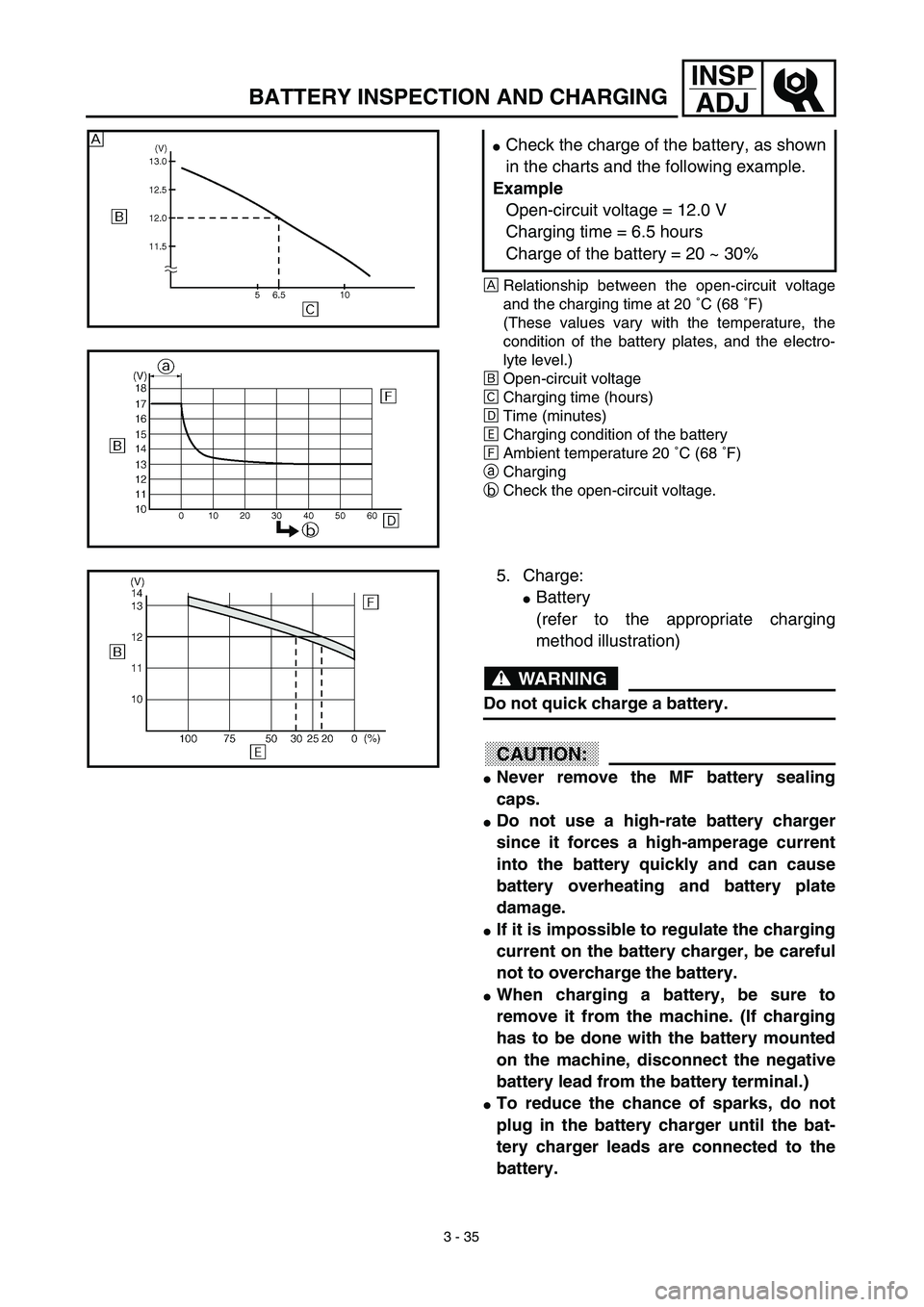Page 26 of 578

CHAPTER 4
ENGINE
SEAT, FUEL TANK
AND SIDE COVERS
..................................4-1
MUFFLER
..................................................4-2
CARBURETOR
..........................................4-3
CYLINDER HEAD
....................................4-12
CAMSHAFT AND ROCKER ARMS
........4-20
VALVES AND VALVE SPRINGS
............4-24
CYLINDER AND PISTON
........................4-32
CLUTCH AND PRIMARY
DRIVEN GEAR
........................................4-40
OIL PUMP
................................................4-49
KICK AXLE AND SHIFT SHAFT
.............4-53
CDI MAGNETO
AND STARTER CLUTCH
.........................4-58
ENGINE REMOVAL
.................................4-63
CRANKCASE, CRANKSHAFT
AND BALANCER
....................................4-67
TRANSMISSION, SHIFT CAM
AND SHIFT FORK
...................................4-75
CHAPTER 5
CHASSIS
FRONT WHEEL AND FRONT BRAKE
(TT-R125E)
................................................5-1
FRONT WHEEL (TT-R125LWE)
...............5-8
FRONT BRAKE (TT-R125LWE)
..............5-12
REAR WHEEL AND REAR BRAKE
.......5-24
FRONT FORK
..........................................5-32
HANDLEBAR
...........................................5-41
STEERING
...............................................5-48
SWINGARM
.............................................5-54
REAR SHOCK ABSORBER
ASSEMBLY
.............................................5-61
CHAPTER 6
ELECTRICAL
ELECTRICAL COMPONENTS
AND WIRING DIAGRAM
...........................6-1
IGNITION SYSTEM
....................................6-2
ELECTRIC STARTING SYSTEM
...............6-6
CHARGING SYSTEM
...............................6-16
Page 94 of 578

SPEC
2 - 23
MAINTENANCE SPECIFICATIONS
EC212300
ELECTRICAL
Item Standard Limit
CDI:
Magneto-model/manufacturer 5HP-10/YAMAHA ----
Source coil resistance (color) 688 ~ 1,032 Ω at 20 ˚C (68 ˚F)
(Brown – Green)----
Pickup coil resistance (color) 248 ~ 372 Ω at 20 ˚C (68 ˚F)
(Red – White)----
CDI unit-model/manufacturer 5HP-00/YAMAHA ----
Ignition coil:
Model/manufacturer 4KJ-10/YAMAHA ----
Minimum spark gap 6 mm (0.24 in) ----
Primary winding resistance 0.18 ~ 0.28 Ω at 20 ˚C (68 ˚F) ----
Secondary winding resistance 6.3 ~ 9.5 kΩ at 20 ˚C (68 ˚F) ----
Spark plug cap:
Type Resin ----
Resistance 10 kΩ at 20 ˚C (68 ˚F) ----
Charging system:
System type CDI magneto ----
Model/manufacturer 5HP-10/YAMAHA ----
Normal output 14 V/100 W at 5,000 r/min ----
Charging coil resistance (color) 0.64 ~ 0.96 Ω at 20 ˚C (68 ˚F)
(White – Black)----
Lighting coil resistance (color) 0.52 ~ 0.78 Ω at 20 ˚C (68 ˚F)
(Yellow – Black)----
Rectifier/regulator:
Regulator type Semiconductor short circuit ----
Model/manufacture SH620B-12/SHINDENGEN ----
No-load regulated voltage 14.0 ~ 15.0 V ----
Rectifier capacity 8 A ----
Electric starting system:
Type Constant mesh
Starter motor:
Model/manufacturer 5HP00/YAMAHA ----
Operation voltage 12 V ----
Output 0.25 kW ----
Armature coil resistance 0.017 ~ 0.021 Ω at 20 ˚C (68 ˚F) ----
Brush overall length 10 mm (0.40 in) 3.5 mm
(0.14 in)
Brush quantity 2 pcs. ----
Spring force 5.52 ~ 8.28 N
(560 ~ 840 g, 19.8 ~ 29.7 oz)----
Commutator diameter 22 mm (0.9 in) 21 mm
(0.8 in)
Mica undercut (depth) 1.5 mm (0.06 in) ----
Page 228 of 578

3 - 33
INSP
ADJ
BATTERY INSPECTION AND CHARGING
WARNING
Batteries generate explosive hydrogen gas
and contain electrolyte which is made of
poisonous and highly caustic sulfuric acid.
Therefore, always follow these preventive
measures:
�Wear protective eye gear when handling
or working near batteries.
�Charge batteries in a well-ventilated area.
�Keep batteries away from fire, sparks or
open flames (e.g., welding equipment,
lighted cigarettes).
�DO NOT SMOKE when charging or han-
dling batteries.
�KEEP BATTERIES AND ELECTROLYTE
OUT OF REACH OF CHILDREN.
�Avoid bodily contact with electrolyte as it
can cause severe burns or permanent eye
injury.
FIRST AID IN CASE OF BODILY CONTACT:
EXTERNAL
�Skin — Wash with water.
�Eyes — Flush with water for 15 minutes
and get immediate medical attention.
INTERNAL
�Drink large quantities of water or milk fol-
lowed with milk of magnesia, beaten egg
or vegetable oil. Get immediate medical
attention.
CAUTION:
Charging time, charging amperage and
charging voltage for an MF battery are dif-
ferent from those of conventional batteries.
The MF battery should be charged as
explained in the charging method illustra-
tions. If the battery is overcharged, the
electrolyte level will drop considerably.
Therefore, take special care when charging
the battery.
BATTERY INSPECTION AND CHARGING
Page 230 of 578
3 - 34
INSP
ADJ
NOTE:
Since MF batteries are sealed, it is not possi-
ble to check the charge state of the battery by
measuring the specific gravity of the electro-
lyte. Therefore, the charge of the battery has
to be checked by measuring the voltage at the
battery terminals.
1. Remove:
�Battery cover
2. Disconnect:
�Battery leads
(from the battery terminals)
CAUTION:
First, disconnect the negative battery lead
1, and then the positive battery lead 2.
3. Remove:
�Battery
4. Measure:
�Battery charge
Measurement steps:
�Connect a pocket tester 1 to the battery
terminals.
Tester positive probe →
battery positive terminal
Tester negative probe →
battery negative terminal
NOTE:
�The charge state of an MF battery can be
checked by measuring its open-circuit
voltage (i.e., the voltage when the positive
terminal is disconnected).
�No charging is necessary when the open-
circuit voltage equals or exceeds 12.8 V.
2
1
BATTERY INSPECTION AND CHARGING
Page 232 of 578

3 - 35
INSP
ADJ
ÅRelationship between the open-circuit voltage
and the charging time at 20 ˚C (68 ˚F)
(These values vary with the temperature, the
condition of the battery plates, and the electro-
lyte level.)
ıOpen-circuit voltage
ÇCharging time (hours)
ÎTime (minutes)
‰Charging condition of the battery
ÏAmbient temperature 20 ˚C (68 ˚F)
aCharging
bCheck the open-circuit voltage.
�Check the charge of the battery, as shown
in the charts and the following example.
Example
Open-circuit voltage = 12.0 V
Charging time = 6.5 hours
Charge of the battery = 20 ~ 30% Å
5. Charge:
�Battery
(refer to the appropriate charging
method illustration)
WARNING
Do not quick charge a battery.
CAUTION:
�Never remove the MF battery sealing
caps.
�Do not use a high-rate battery charger
since it forces a high-amperage current
into the battery quickly and can cause
battery overheating and battery plate
damage.
�If it is impossible to regulate the charging
current on the battery charger, be careful
not to overcharge the battery.
�When charging a battery, be sure to
remove it from the machine. (If charging
has to be done with the battery mounted
on the machine, disconnect the negative
battery lead from the battery terminal.)
�To reduce the chance of sparks, do not
plug in the battery charger until the bat-
tery charger leads are connected to the
battery.
BATTERY INSPECTION AND CHARGING
Page 234 of 578
3 - 36
INSP
ADJ
�Before removing the battery charger lead
clips from the battery terminals, be sure
to turn off the battery charger.
�Make sure the battery charger lead clips
are in full contact with the battery termi-
nal and that they are not shorted. A cor-
roded battery charger lead clip may
generate heat in the contact area and a
weak clip spring may cause sparks.
�If the battery becomes hot to the touch at
any time during the charging process,
disconnect the battery charger and let the
battery cool before reconnecting it. Hot
batteries can explode!
�As shown in the following illustration, the
open-circuit voltage of an MF battery sta-
bilizes about 30 minutes after charging
has been completed. Therefore, wait 30
minutes after charging is completed
before measuring the open-circuit volt-
age.
BATTERY INSPECTION AND CHARGING
Page 236 of 578
3 - 37
INSP
ADJ
Charging method using a variable voltage charger
BATTERY INSPECTION AND CHARGING
Page 237 of 578
3 - 38
INSP
ADJ
Charging method using a constant voltage charger
BATTERY INSPECTION AND CHARGING